Winning Big: The PPAI Expo Celebrates 20 Years In Las Vegas

The PPAI Expo 2023 will mark the Association’s 20th year holding the industry’s biggest and most important trade show at Mandalay Bay Convention Center in Las Vegas.
Today, many promo veterans have been to Vegas enough time to lose track, but The PPAI Expo has a history that dates back well before it set up its booths on The Strip.
In fact, The PPAI Expo’s move from Dallas, where it had been held for years, was one of the biggest decisions in Association history, one shrouded in secrecy and which posed a legitimate risk that the event wouldn’t happen at all.
It was a gamble, and rumors were swirling about whether it would work.
To create an oral history of the move, PPAI Media caught up with a few of the decision-makers, influential voices and people on the ground leading up to that first event in Las Vegas in 2003. We found out why the event moved west, the enormous risks that came with the decision and how a select few stayed tight-lipped regarding “the best kept secret in this association’s history.”
What follows is the story of a decision that changed the promotional products industry to this day.
A Decline in Dallas: “Something had to be done.”
The PPAI Expo was held in Dallas, near PPAI’s headquarters, for 27 years. In 1999, the event reached a new high watermark in terms of exhibitor booths. But when the event came around that year, things didn’t look like a celebration.
Steve Slagle (PPAI president and CEO, 1996-2012): We exceeded the convention center in Dallas. We were [setting up booths] in concourses and hallways and so forth.
More important than the logistical issues was the fact that distributor attendance did not match the high exhibitor volume, a trend that continued over the next few years. At the turn of the century, Dallas had stopped developing in ways that excited out-of-towners. And yet still, people came, making it the largest trade show in the industry.
 Wayne Greenberg (PPAI board chair 2002-2003): The PPAI Expo 2001 and 2002 saw a good-sized drop-off in distributors.
Wayne Greenberg (PPAI board chair 2002-2003): The PPAI Expo 2001 and 2002 saw a good-sized drop-off in distributors.
What the board knew was that Dallas, as a town, had become complacent and boring. No new restaurants, no new anything. [Some of] the hotels were taking us for granted. As much as Expo was still the premier event in the industry, people were beginning to think, ‘I’ll skip it this year. I’ve seen it before. I’ve been there before.’
[The PPAI Expo] is very important to the infrastructure of our association. Something had to be done.
Tina Berres Filipski (PPAI director of publications, 1995-2022): The PPAI Expo has always been the Association’s centerpiece and one of its largest sources of revenue, so keeping it robust was of paramount importance. PPAI was willing to do whatever it took to continue strengthening the show. It was obvious to everyone – staff, board and members – that The PPAI Expo had outgrown the Dallas Convention Center, so moving it was a logical and natural next step.
Discussions of moving The PPAI Expo to another city were happening in an unofficial capacity, but after a quarter - century in Dallas and contracts with hotels in the city, such discussions were only whispered rumors to most.
Slagle: We started looking for other locations in late 2000.
Greenberg: Up until that point, there weren’t any facilities in the United States big enough to hold Expo. Dallas Convention Center was actually it. It was kind of like, ‘We’ve got to get out of this place, but where do we go? What can we do?’
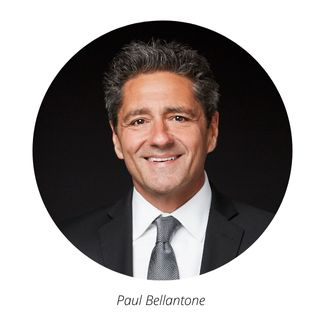 Paul Bellantone (PPAI’s vice president, marketing and communications 2001-2004; future president and CEO of PPAI): I was more frightened that we would do nothing.
Paul Bellantone (PPAI’s vice president, marketing and communications 2001-2004; future president and CEO of PPAI): I was more frightened that we would do nothing.
Slagle: We looked in New Orleans, Chicago and Orlando.
Greenberg: In July of 2001, the [PPAI] board met for a hastily called meeting in Chicago while we were in the city for a trade show called Promotions Midwest. The board was called into session to be presented with the fact that this hotel in Las Vegas called Mandalay Bay was going to build a brand-new convention center that would be big enough to hold The Expo.
The board told Mandalay Bay that PPAI had some preliminary interest, but a few things needed to be sorted out. Mandalay Bay was so early in its planning that the rules and regulations weren’t all quite in place. There weren’t any non-compete clauses preventing the venue from holding an unaffiliated promo trade show the next month, for example. And the earliest date that could be offered was February, a month later than The PPAI Expo’s typical date.
Greenberg: The board was divided [in that moment] between leaving Dallas and going to Vegas.
Dale Denham (current PPAI president and CEO; ASI senior vice president, 2000-2010): The Dallas show had a long history in the industry.
Greenberg: People don’t like change. A lot of people just didn’t want to make that change.
Nevertheless, a straw vote was in favor of moving, but it was only a straw vote, depending on what the rules and regulations were.
PPAI didn’t make any commitments in July 2001, and two months later tragedy struck the country on September 11, 2001. Construction was halted on Mandalay Bay.
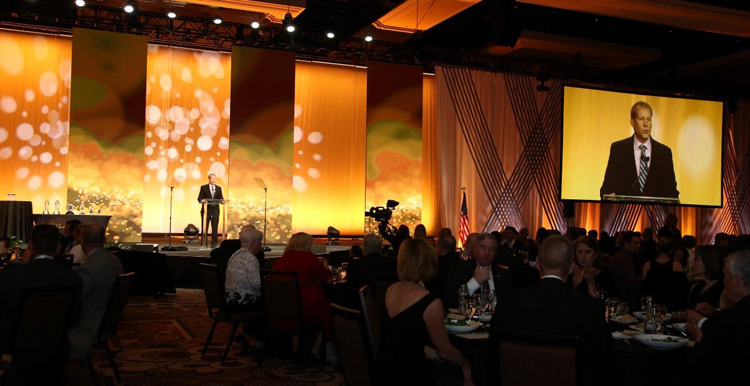
Revisiting The Idea: “What are you doing tomorrow at 9:30?”
The PPAI Expo 2002 was held in Dallas again in January. Meanwhile, the board was still looking for another option, and it was time for the board’s yearly strategic planning meeting. They decided to hold it two days before the ASI trade show in March, where they would all already be, anyway. It just so happened to be in Las Vegas.
Greenberg: I took the gavel in January of 2002. What was clearly on everybody’s mind was that the 2002 Expo was down quite a bit.
The topic of moving The PPAI Expo came up in the meeting, and the board wondered what the state of Mandalay Bay was at this point. As the meeting wrapped up, Bren Clevenger-Ori (PPAI vice president of program services from 1997-2003) decided to pick up the phone and call the sales manager of Mandalay Bay.
Greenberg: I was in the room listening to her side of the conversation. It was Steve [Slagle], myself, Bren and Paul Lage, who was the incoming Board Chair. All I heard was, ‘When do you start building again?’ The answer he gave her was, ‘We started March 1.’ This was March 11. Then Bren asked, ‘What are you doing tomorrow at 9:30?’ He responded, ‘Well, I guess I’m meeting with you all.’
As board chair, Greenberg had obligations the next morning and was unable to meet with Mandalay Bay. Slagle, Clevenger-Ori and Lage went to the construction site and met with the sales manager.
Slagle: They took us up in a suite on a high floor and we could see the footprint and the construction was underway. There was a lot left to do. We thought 2004 would be more realistic. They said, ‘Well, we’ve got January 2003 open now. And we sort of thought, ‘OK, but can you finish the building in time?’ This was March 2002.
Paul Lage (PPAI Board Chair, 2003-2004): We had a great meeting with the head of conventions for Mandalay and this opportunity was evolving quickly. I remember looking out over empty piece of land where the convention center was going to be constructed. There was no way that this was going to be done in time.
That morning, the Mandalay Bay team made their first promise that the building would be finished in eight months. It wouldn’t be the last time they’d have to reiterate that assurance.
Greenberg: Paul, Steve and Bren came on the ASI show floor [after their Mandalay Bay meeting]. I was in the PPAI booth. I looked at them. Paul looked like the cat that just ate the bird. He’s smiling. I said, ‘2004?’
Lage shakes his head, smiling.
‘2003?’
Lage’s smile widens. He nods.
A Tightlipped Board: “They had to spend 15 days on mute.”
The official decision took place on an April 3 conference call among the board. Slagle was on the call from PPAI headquarters, where the rest of the staff was unaware of the conversation that would alter the careers of many.
Slagle: Me and two others were the only staff members who knew we were looking at Mandalay Bay for 2003. We hadn’t even told our director of expositions, Darel Cook.
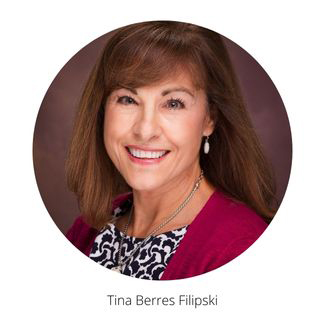 Filipski: If there was a buzz around the office, it was a positive one.
Filipski: If there was a buzz around the office, it was a positive one.
Greenberg: There are a lot of reasons for me to be proud of my board. One was the absolute confidentiality they kept. Once we voted to go to Las Vegas, that was April 3, and the contract wasn’t done until April 18. So, they had to spend 15 days on mute.
The next thing that happened once the contract was signed, we immediately pulled the trigger. We had conference calls with every single committee PPAI had back then. Then the staff was gathered, because almost all of the staff didn’t know. Then once the staff heard the news, by about 11 a.m. the emails went out to the industry.
Keith Vincent (PPAI director of marketing, 2002-present): I remember thinking it was a bad idea and suggesting we wait a year. It wasn’t that I thought moving to Vegas was a bad idea, but at the time, Mandalay Bay Convention Center wasn’t built.
Slagle: It was probably the best kept secret in Association history.
Moving Blindly: ‘What if they don’t get the doggone building done?’
The decision had been made. The contract was signed. But would Mandalay Bay be ready able to deliver their promise of a finished convention center?
Slagle: We spent about as much time, as I remember, working on the prospect of them not completing the building as we did on them completing the building. We had to have a backup plan.
The backup plan Mandalay Bay offered was the property across the street from the convention center – a parking lot.
Slagle: They said they could construct what they called ‘tented structures.’
Translation: tents.
Slagle: We were skeptical, believe me. They said, ‘Look, if for some reason that won’t work for you, we will reimburse your cost.’ That was built into the contract. But that didn’t solve our problem, because we needed to have The PPAI Expo that year. But we crossed our fingers and negotiated our contract. We had done our homework and had a good plan.
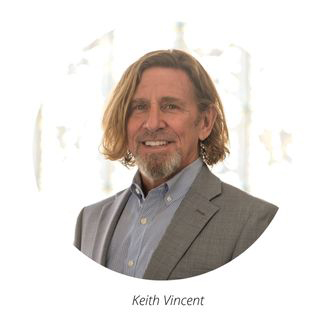 Vincent: I was new, and the idea of having to market the move of a well-established trade show to a new city and a convention center that wasn’t even complete yet seemed like a pretty big ask, not to mention a bit risky for the show itself.
Vincent: I was new, and the idea of having to market the move of a well-established trade show to a new city and a convention center that wasn’t even complete yet seemed like a pretty big ask, not to mention a bit risky for the show itself.
Greenberg: A big part of the story is the courage of the PPAI Board of Directors, who voted to move a 25,000-person Expo in nine months to a building that didn’t have a roof yet. It didn’t even have a second floor yet.
Bellantone: When faced with the realization that not moving The PPAI Expo was riskier than the construction and logistics, it became a matter of seamless execution, not endless evaluation and second guessing.
Slagle: The board was just as skeptical as staff about, ‘What if they don’t get the doggone building done?’
Things became even more tense in August when a rumor came out in an industry publication that Mandalay Bay would not be ready for The PPAI Expo in January. Greenberg was in Long Beach, California, with his wife, Debbie, for the SAAC show when the report came out. Telephone assurances wouldn’t suffice in this instance.
Greenberg: We called our [Mandalay Bay] sales manager, and I said, ‘I want a hardhat tour.’ So, Debbie and I drove through the desert, and we went to Vegas, where they hosted us. [Afterwards] I was able to announce that the building that didn’t have a second floor in April was hanging wallpaper on the third floor when we visited.
Slagle: We went in December for an executive committee meeting of the Board to see the finished product. They were still painting. They were still doing things in the interior, but the structure was up. They delivered. We were like, ‘We don’t believe you did this in nine months.’ We were the first full-building trade show they held.
The Moment Arrives: “There were a lot of heroes that year.”
While people both inside and outside of PPAI headquarters wondered if Mandalay Bay would finish construction in time, PPAI staff had a monumental task of preparing to hold the industry’s biggest event based solely on blueprints. Slagle, meanwhile, had to break the news to the Dallas Convention Center and address the contracts PPAI had with Dallas hotels.
Slagle: The biggest cost to us was the hotel contracts, some of which were three years in duration.
Greenberg: Steve and David Woods (PPAI chief operating officer, 2002-2003), aka Butch Cassidy and the Sundance Kid, went to see each of the hotels with checks in hand.
Slagle: We went to all the hotels in Dallas, met with them and talked about what we were doing. And we made good on all the contracts we had in place. We paid, in my memory, just over $1 million to those hotels to satisfy the contracts. So, we left town feeling like we had fulfilled our obligations to the city and the properties there. We didn’t try to sneak out of town in the middle of the night to go to Vegas.
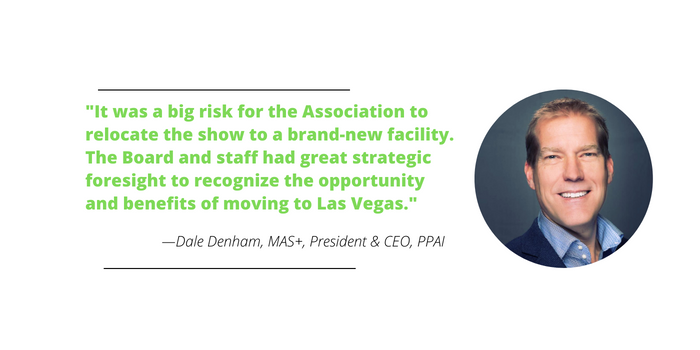
Greenberg: There were a lot of heroes that year.
Slagle: There are all those terms, serendipity and all that kind of stuff, but it was a lot of hard work.
Greenberg: One that needs a lot of mention is Darel Cook. He’s the one who laid out that 1,800 supplier shows and 3,200 booths working strictly from architectural designs. Bren for getting it done. Paul Bellantone and Keith Vincent were tasked with selling the idea of moving out of Dallas, which had such a long tradition.
Vincent: I think once the decision was final, we all kicked it into gear and didn’t look back. There were certainly some nervous moments, but the team at the time felt strongly that the move to Vegas was an exciting one and right for the future of the event.
Slagle: Wayne Greenberg was the cheerleader. He really worked hard with the board of directors.
Greenberg: It was Steve’s staff, but Steve had the vision and the respect of his staff to work as hard as they did.
Slagle: Oh, my gosh, I was surrounded by some really competent, talented and skilled people.
Bellantone: When we got the unanimous green light from the Board, it was a game-changer. It became time to focus on execution, which the teams did flawlessly.
It seemed Bellantone and Vincent’s teams had done their job and the appeal of Las Vegas was working when the registration numbers were looking very positive.
Slagle: Would they all show up?
Denham: The success was clear from the first day of the event. I remember being impressed with how smooth the first show went. It was easier to get to the convention each day, the education rooms were better, the show floor was much better, and essentially every aspect of the experience was improved.
Slagle: Everyone went, ‘Holy cow, this is different.’
Pro Basketball Hall of Famer and businessman Magic Johnson was a keynote speaker for the opening session.
Greenberg: Everybody was walking around starstruck. They couldn’t believe how beautiful it was. They were all finding their way around the different floors of a building they had never seen before. They broke all kind of records. We had a party. It was great.
Vincent: As I remember it, there were some challenges, as you would expect when yours is the first major show in a brand-new convention center, but overall, the event was a success. And it was clear after the first year, the right decision had been made for the future of The PPAI Expo.
The relationship between PPAI and the Mandalay Bay Convention Center has continued to blossom in the more than two decades since.
Denham: It was a big risk for the Association to relocate the show to a brand-new facility. The Board and staff had great strategic foresight to recognize the opportunity and benefits of moving to Las Vegas.
Greenberg: I wear my heart on my sleeve. And it’s one of the things, I think, that endeared me to my board. I didn’t play politics in any way, shape or form. The thing that my board knew and understood was that, unlike Dallas, Vegas reinvents itself every few years.
A little over four months before The PPAI Expo, an industry publication reported a rumor that the Mandalay Bay Convention Center would not be completed in time for the event. So PPAI Board Chair Wayne Greenberg and his wife, Debbie, drove from the trade show they were attending in Long Beach, California, to Las Vegas and insisted on a hardhat tour so that he could provide personal assurance the project was on track.
The 2002-2003 PPAI Board of Directors Officers who voted to move
The PPAI Expo to Las Vegas
Officers:
Chairman of the Board:
Wayne Greenberg
Chairman-Elect of the Board:
Paul Lage
Immediate Past Chairman of the Board:
Bob Davis
Vice Chair:
Brian Rechten
Vice Chair:
Donnamarie Senn
Vice Chair:
Tom Elsbernd
Vice Chair:
Laura Forbes
Directors:
Katherine Burke
Charles Pecher
Carol D. Aastad
Patricia Dugan
Mary Ellen Sokalski
William F. Jarman Jr.
Margie Price
Barbara Gerlach
Carole Hill
Danny Simon
Keith Olivit
A Timeline of Expo Memories:
2003
First PPAI Expo at Mandalay Bay Convention Center in Las Vegas. Magic Johnson speaks during opening session.
2007
Mick Fleetwood of Fleetwood Mac performs a live concert for the Expo attendees.
2011
PPAI announces on the Expo stage a partnership with SAGE that continues to this day.
2015
The PPAI Expo changes its format to a Sunday-Thursday schedule with exhibits open Tuesday through Thursday.
2020
The PPAI Expo’s highest on-site attendance ever.
2021
Due to the COVID-19 pandemic, PPAI hosts its first virtual trade show, PPAI Expo Direct-2-You.
2022
The PPAI Expo returns to an in-person format headlined by Promopalooza: The PPAI Expo Party, live from Allegiant Stadium.
2023
The 20th PPAI Expo to be held at Mandalay Bay Convention Center in Las Vegas.

